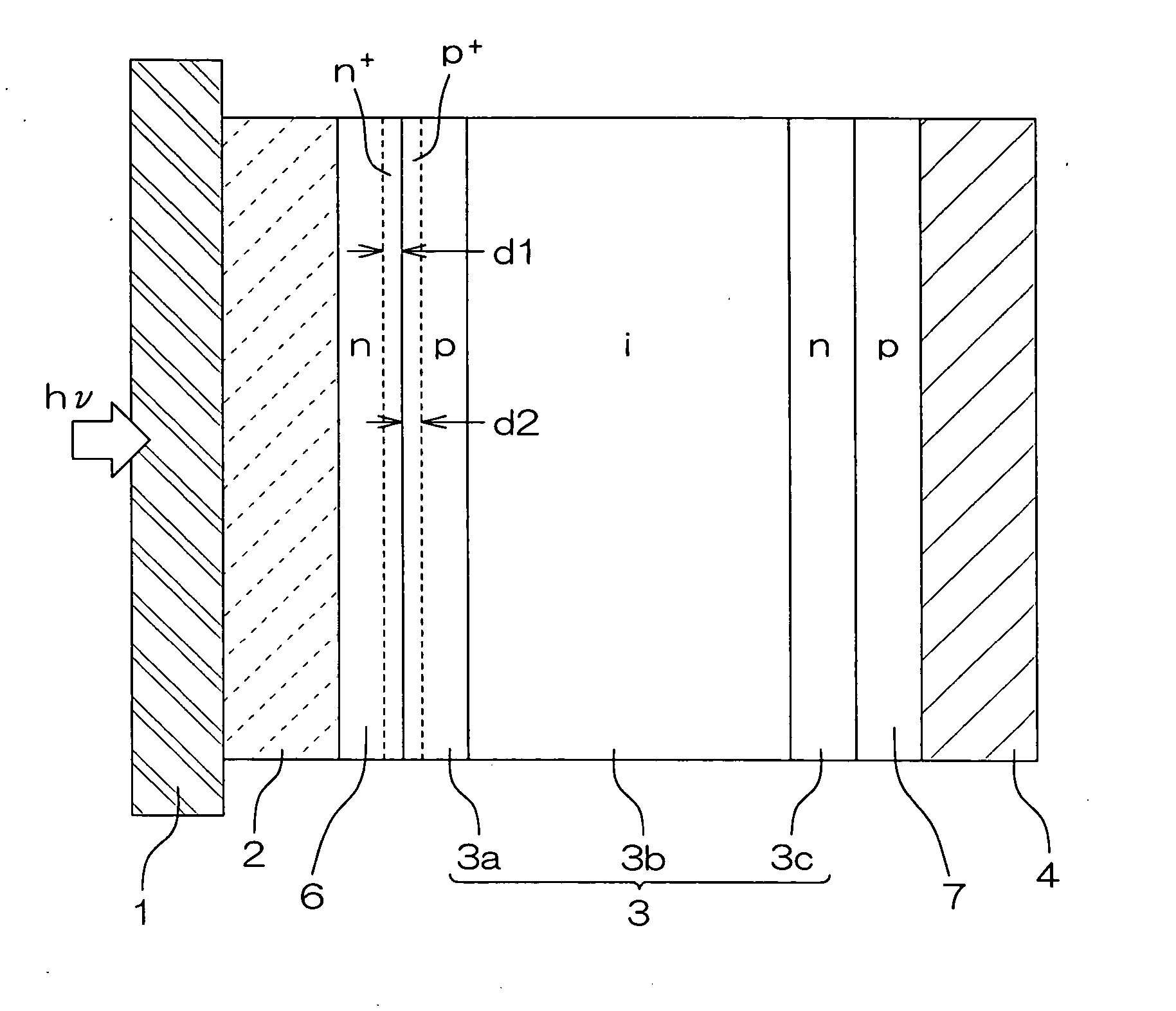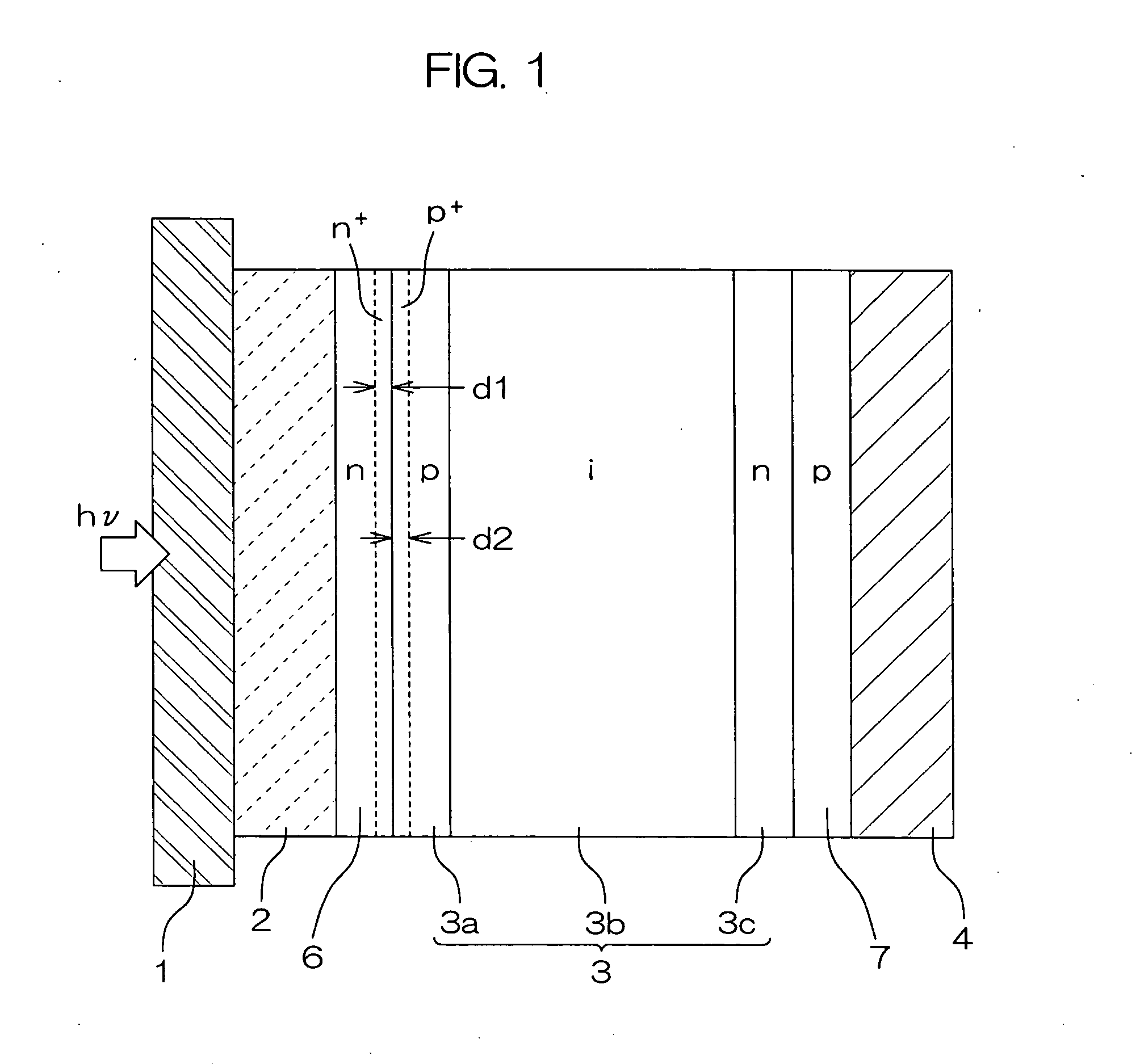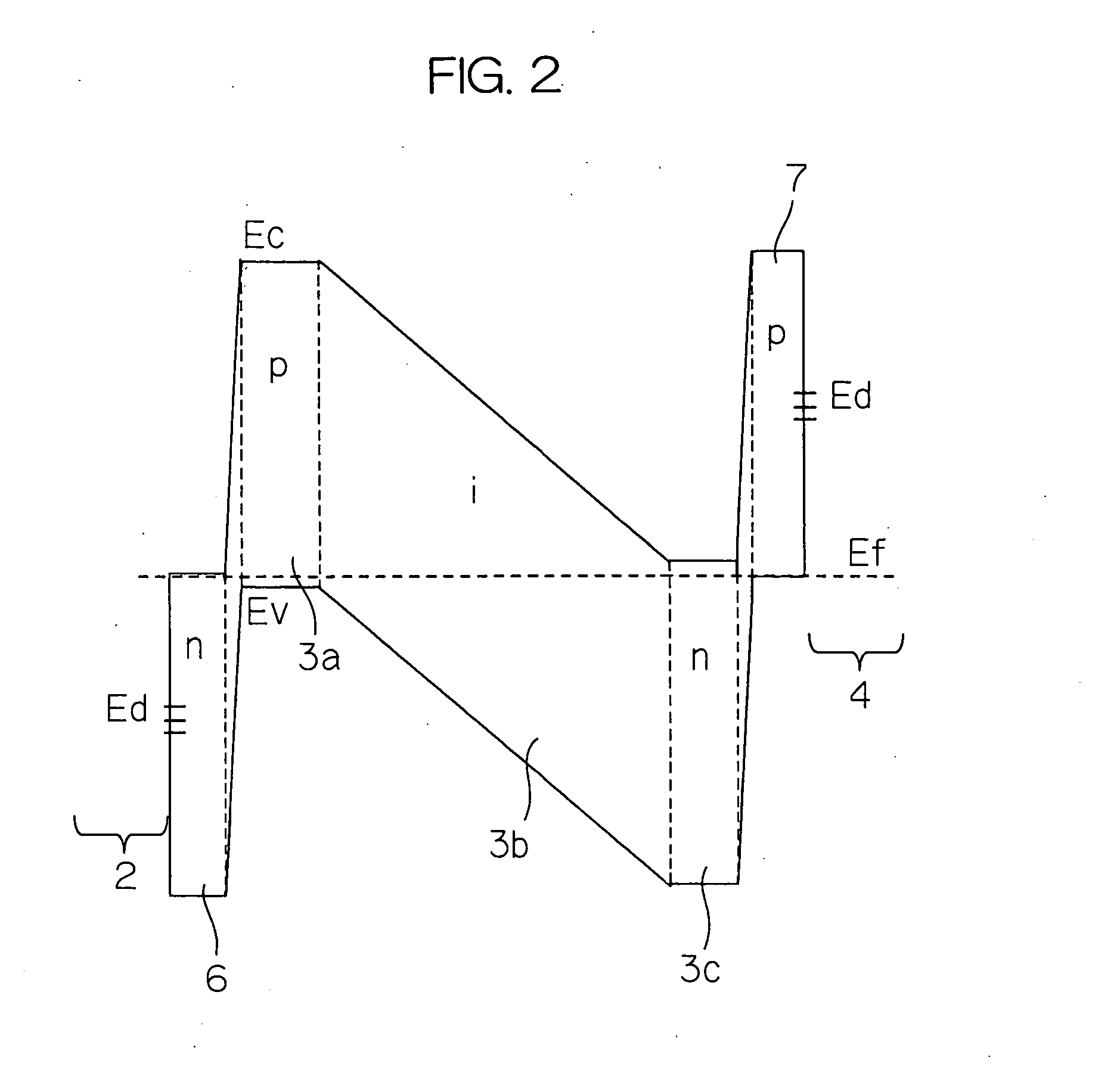Semiconductor/electrode contact structure and semiconductor device using the same
a contact structure and semiconductor technology, applied in the direction of superconductor devices, semiconductor devices, electrical devices, etc., can solve the problem of limitation of obtained effect, and achieve the effect of reducing the carrier recombination rate r and reducing the recombination center density nr
- Summary
- Abstract
- Description
- Claims
- Application Information
AI Technical Summary
Benefits of technology
Problems solved by technology
Method used
Image
Examples
example 1
[0301] The thin film silicon solar cell device was manufactured on the basis of the configuration shown in FIG. 3 in the present invention. Manufacturing conditions are shown in Table 1.
TABLE 1p-typesemiconductorFirstn-type semiconductor layer 31dlayer 31aelectrode 2Doping elementElement forBand gapSi crystalDoping elementSampleConstituentconcentrationThicknessenlargingwidthphase isconcentrationNo.material(cm−3)(nm)band gap(eV)included(cm−3)*1SnO2—————1E19˜7E202SnO23E19˜1E212—1.1˜1.3◯1E19˜7E203SnO2—————1E19˜7E204SnO23E19˜1E212—1.1˜1.3◯1E19˜7E20*5SnO25E+172—1.1˜1.3◯1E19˜7E206SnO22E+182—1.1˜1.3◯1E19˜7E207SnO23E+212—1.1˜1.3◯1E19˜7E20*8SnO26E+212—1.1˜1.3◯1E19˜7E209SnO23E19˜1E214—1.1˜1.3◯1E19˜7E2010SnO23E19˜1E217—1.1˜1.3◯1E19˜7E2011SnO23E19˜1E2118 —1.1˜1.3◯1E19˜7E2012SnO23E19˜1E2125 —1.1˜1.3◯1E19˜7E20*13SnO23E19˜1E212—1.1˜1.3◯1E19˜7E2014SnO23E19˜1E212—1.1˜1.3◯1E19˜7E2015SnO23E19˜1E212—1.1˜1.3◯1E19˜7E20*16SnO23E19˜1E212—1.1˜1.3◯1E19˜7E2017SnO23E19˜1E212—1.1˜1.3◯1E19˜7E2018SnO23E19˜1E212...
example 2
[0314] The bulk type solar cell device shown in FIG. 6 according to the present invention was manufactured in the following manner. Manufacturing conditions are shown in Table 3.
TABLE 3Frontp-type Si-BSFRearelectrodep-type Si region 503n-type Siregion 506n-type Si region 507electrode501Dopingregion 504DopingDoping508MainelementThick-Si crystalDoping elementelementelementThick-Si crystalMainSampleconstituentconcentrationnessphase isconcentrationconcentrationconcentrationnessphase isconstituentNo.material(cm−3)(nm)included(cm−3)(cm−3)(cm−3)(nm)includedmaterial*1Ag——◯2E19˜2E212E18˜1E19——◯Ag2Ag1E+195◯2E19˜2E212E18˜1E19——◯Ag3Ag——◯2E19˜2E212E18˜1E193E+1910◯Ag4Ag1E+195◯2E19˜2E212E18˜1E193E+1910◯Ag
* is an example outside the scope of the present invention.
[0315] A p-type Si substrate having a thickness of 300 μm (a dopant B concentration is 2×1016 cm−3) was taken as the p-type Si photoactive region 505, and the n-type Si region 504 was formed thereon so that the doping element concentrat...
example 3
[0323] The thin film silicon solar cell device having the configuration shown in FIG. 7 according to the present invention was manufactured. Manufacturing conditions are shown in Table 5.
TABLE 5Trans-p-typen-typeparentlayerlayer 31cp-type layer 31dinter-n-type layer 32d32aDopingDopingElementSimediateDopingElementSiDopingelementelementfor en-Bandcrystallayer 5elementfor en-BandcrystalelementSam-concen-concen-Thick-larginggapphaseCon-concen-Thick-larginggapphaseconcen-pletrationtrationnessbandwidthis in-stituent trationnessbandwidthis in-trationNo.(cm−3)(cm−3)(nm)gap(eV)cludedmaterial(cm−3)(nm)gap(eV)cluded(cm−3)*13E19˜1E21—————ZnO————01E19˜7E2023E19˜1E213E19˜1E212—1.1˜1.3◯ZnO—————1E19˜7E2033E19˜1E21—————ZnO1E19˜7E205—1.1˜1.3◯1E19˜7E2043E19˜1E213E19˜1E212—1.1˜1.3◯ZnO1E19˜7E205—1.1˜1.3◯1E19˜7E2053E19˜1E215E172—1.1˜1.3◯ZnO1E19˜7E205—1.1˜1.3◯1E19˜7E2063E19˜1E212E182—1.1˜1.3◯ZnO1E19˜7E205—1.1˜1.3◯1E19˜7E2073E19˜1E213E212—1.1˜1.3◯ZnO1E19˜7E205—1.1˜1.3◯1E19˜7E2083E19˜1E216E212—1.1˜1.3◯ZnO...
PUM
 Login to View More
Login to View More Abstract
Description
Claims
Application Information
 Login to View More
Login to View More - R&D
- Intellectual Property
- Life Sciences
- Materials
- Tech Scout
- Unparalleled Data Quality
- Higher Quality Content
- 60% Fewer Hallucinations
Browse by: Latest US Patents, China's latest patents, Technical Efficacy Thesaurus, Application Domain, Technology Topic, Popular Technical Reports.
© 2025 PatSnap. All rights reserved.Legal|Privacy policy|Modern Slavery Act Transparency Statement|Sitemap|About US| Contact US: help@patsnap.com



